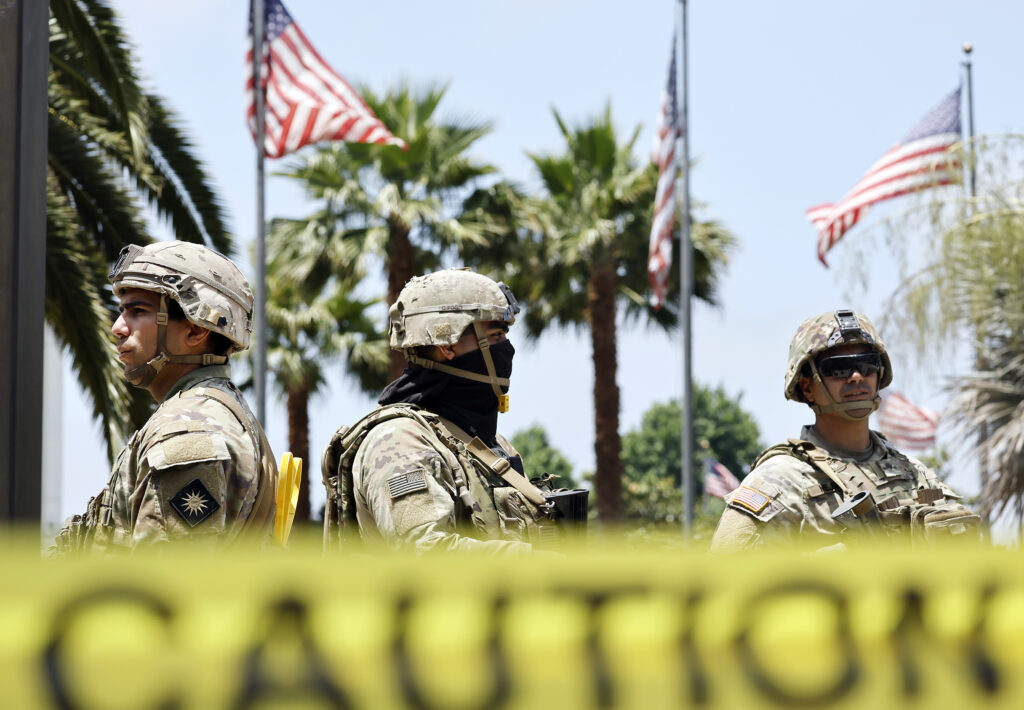Trial Sheds Light on Sweeping Theory Behind Trump’s Military Deployments

The broad legal theory behind President Donald Trump’s use of the military in civilian law enforcement took center stage Tuesday during day two of a trial over the deployment of National Guard troops and Marines to Los Angeles earlier this year.
The three-day, non-jury trial before San Francisco-based federal Judge Charles Breyer concerns California’s claim that Trump’s use of troops in Los Angeles violated the Posse Comitatus Act of 1878, which generally prohibits using the military in civilian law enforcement purposes under normal circumstances.
California has argued that the Trump administration violated Posse Comitatus by deploying soldiers alongside federal agents carrying out immigration raids, executing arrest warrants and conducting drug operations.
Troops, the state alleged, have played an “active, direct role” in law enforcement activities by performing security functions during operations, setting up perimeters and blockades and, on at least two occasions, detaining civilians.
The Department of Justice has claimed that the military’s ongoing mission in Los Angeles is permissible under Posse Comitatus because troops are protecting federal property and federal law enforcement officials.
The Trump administration deployed over 5,000 National Guard soldiers and Marines to southern California, and the troops have assisted with over 170 law enforcement operations carried out by several different federal agencies, according to the Pentagon.
While the Pentagon has ended the deployment of many of the troops, around 250 National Guard members remain active in Los Angeles.
The second day of trial again saw testimony from Maj. Gen. Scott Sherman, the head of Task Force 51, which oversaw the National Guard troops and Marines involved in the military mission to Los Angeles.
Sherman said soldiers were given training materials on Posse Comitatus. These materials included a list of specific activities prohibited by the act: Security patrols, traffic control, crowd control and riot control.
Though the act prohibits members of the military from carrying out certain actions, Sherman said there was a “constitutional exception” that permitted such activities under certain circumstances.
Breyer, an appointee of former President Bill Clinton and the brother of former Supreme Court Justice Stephen Breyer, interjected and said he wasn’t aware of any such exception and asked the major general to expand.
After stressing that he’s not a lawyer, Sherman said Department of Defense attorneys advised him that the military was allowed to carry out prohibited activities because such acts were “in line” with Trump’s order for troops to protect federal property and personnel.
Sherman added he was told that the exception was triggered because Trump claimed the actions in Los Angeles constituted a “rebellion” against the federal government that prevented federal officials from doing their jobs.
While facing questions from California’s attorneys, Sherman insisted that soldiers could only carry out prohibited acts if there was an “imminent threat” to law enforcement officials.
That appeared to conflict with the general’s testimony during the first day of the trial, during which he said that troops accompany law enforcement agents even when agents face minimal threats.
The advice Sherman said he received appears to derive from an expansive controversial theory of executive authority called the “protective power.” It asserts that presidents have inherent constitutional authority to use the military to protect federal property, personnel and functions and that such actions cannot violate Posse Comitatus.
The theory, which is not explicitly found in the Constitution but is instead a legal interpretation of the Take Care Clause, served as the basis of Trump’s deployment of National Guard troops and Marines to Los Angeles.
Sherman said he received no reports of Posse Comitatus violations throughout the military’s mission in Los Angeles. However, he acknowledged that he was not present, and was not part of the chain of command, for many of the operations.
During oral arguments Tuesday, Breyer questioned the DOJ on whether there were any limits to using the military to protect agents conducting law enforcement operations.
“Where are the limits?” Breyer asked.
In response, DOJ attorney Eric Hamilton did not state any restrictions and claimed that the president’s protective power is an exception to Posse Comitatus.
Day two of the trial came as members of the National Guard began arriving in Washington, D.C., a day after Trump ordered hundreds of troops to assist law enforcement agents in the nation’s capital.
Trump claimed that the National Guard deployment and surge in federal personnel in D.C. is necessary to address violent crime in the district, even as data from D.C. police show that crime is in decline.
While deploying Guard troops to D.C., Trump threatened that other Democrat-run cities like New York and Chicago could be next.
During the trial’s first day, Breyer noted that his decision in the case could affect how Trump uses military troops during future deployments.
Sherman’s testimony Monday revealed his loyalty to the country was questioned by a Trump official after the commander objected to a request for military assistance for a large multi-agency operation at a public park in Los Angeles.
It also revealed that a platoon of troops attended an FBI briefing on an upcoming arrest operation on a suspect in Carson, California. As part of the operation, soldiers were assigned to block roads so that FBI and Drug Enforcement Administration agents could carry out a raid on the suspect’s home.